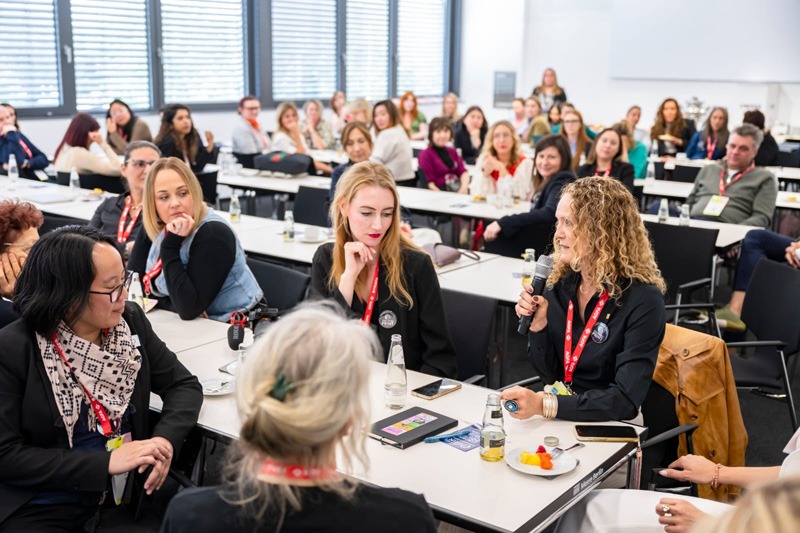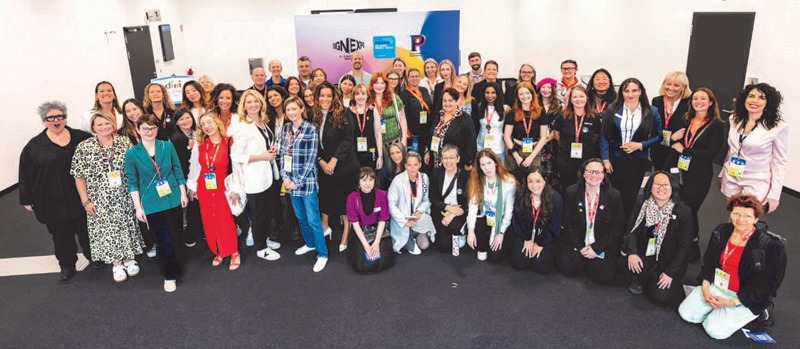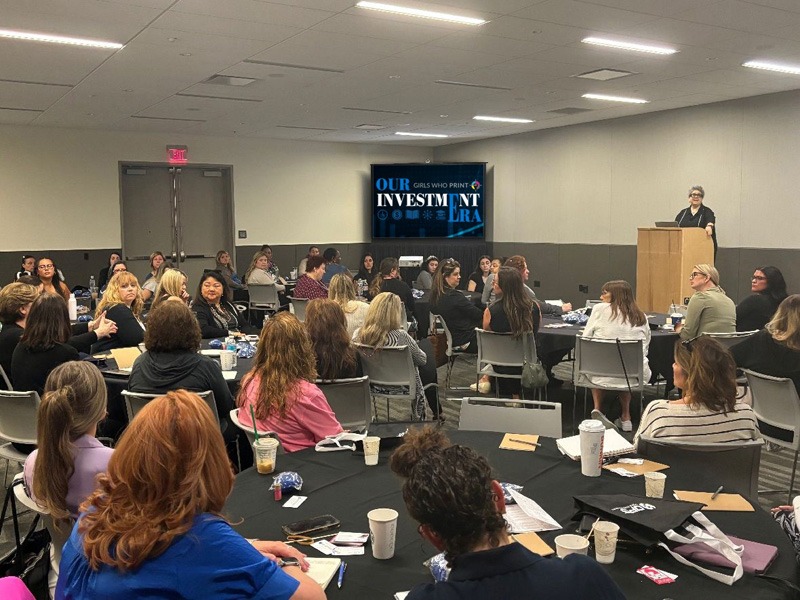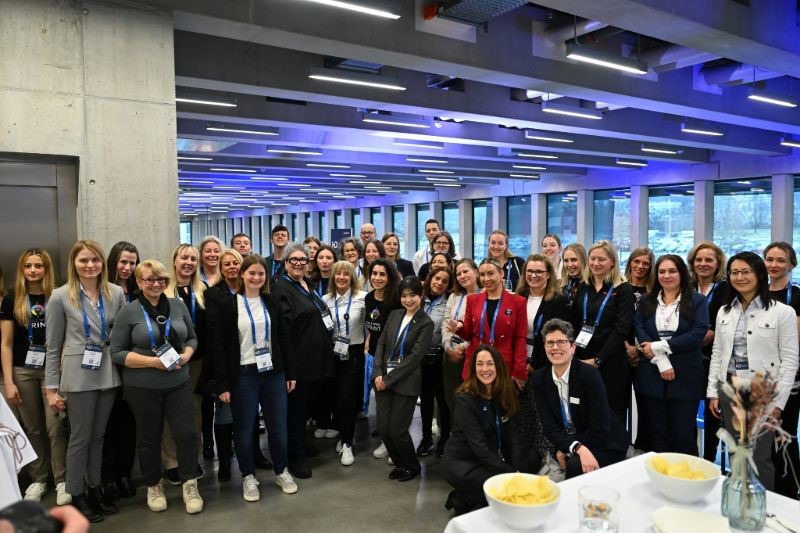Girls just wanna print
How Girls Who Print is reshaping what’s possible for women in the print world

From humble beginnings as a LinkedIn group, Girls Who Print is now a global nonprofit powerhouse that is a key pillar in the print industry. Girls Who Print’s mission is to ensure its 11,500 members can access a robust network of incredible women and allies in the printing and graphic communication industry. By empowering women, fostering mentorship, and opening new doors across the globe, the organization is reshaping what’s possible for women in the print world.
Deborah Corn, executive director of Girls Who Print, and Joanne Gore, the organization’s representative in Canada, share the network’s inspiring journey with Sign Media Canada.
Sign Media Canada (SMC): How did Girls Who Print get started, and what inspired its transformation into the organization it is today?
Deborah Corn (DC): Girls Who Print started as a simple online group in 2009, built around the idea that girls who print needed a space to connect, share, and be visible. What inspired its transformation into the organization it is today is the recognition that visibility alone wasn’t enough. We needed programs, mentorship, and advocacy to truly move the needle for women in this industry. Over the years, we’ve grown from a conversation into a nonprofit global organization and the world’s largest network of women in print and graphic communications that also offers resources, education, and community support for women at different stages of their careers. And as of this year, Girls Who Print is officially recognized as a nonprofit organization, which allows us to expand our reach and impact even further.
Joanne Gore (JG): Girls Who Print Canada is focused on addressing women’s lack of visibility, representation, and leadership opportunities across our country’s diverse print landscape. While women make up nearly 48 per cent of the overall Canadian workforce, they represent only about 25-30 per cent of the workforce in the print and graphic communications sector—and far fewer in leadership and technical roles.1 From coast to coast, women in print are doing incredible work, but their stories are often underrepresented. We’re working to change that by fostering mentorship, building a supportive network, and creating programs tailored to the Canadian market.

SMC: What core challenges in the print and graphic communications industry is Girls Who Print working to address?
DC: We’re working to address two big challenges: Representation and retention. Women are underrepresented in leadership roles across the industry, and many leave because they don’t see a clear path for advancement or feel isolated in their roles. We also know there’s a talent pipeline issue in getting the next generation excited about print. Girls Who Print is helping solve both by creating networks of support, mentorship, and visibility, and by showing students and young professionals that there is a community here ready to lift them up.
JG: In Canada, we want to spotlight women working in all print sectors—packaging, signage, direct mail, commercial, and in-plant—and ensure they have the resources, recognition, and community they need to thrive.
SMC: How do you measure the impact of your work?
DC: Impact for us is both quantitative and qualitative. Quantitatively, we look at growth in membership, number of chapters, and engagement in our programs. Qualitatively, it’s the success stories: women who land jobs through our network, find mentors through our programs, or gain the confidence to step into leadership roles. Every time a woman says, “I didn’t think I could do this until I connected with Girls Who Print,” that’s impact.
JG: Our intended results in Canada include growing a vibrant LinkedIn community through the Girls Who Print Canada page and group, engaging Canadian women through surveys, webinars, and events, and building partnerships with Canadian print associations, schools, and businesses to support emerging talent.
SMC: How has women’s experience in print changed over the years?
DC: The shift is slow, but it’s happening. Women are gaining more visibility, stepping into leadership roles, and being recognized for their expertise in ways that weren’t common even a decade ago. There’s still work to do, but today there’s a stronger sense of community, more support systems like Girls Who Print, and greater confidence among women to claim their space in the industry.
JG: Canada’s print industry is evolving, and we are seeing a growing appetite for connection, recognition, and leadership development amongst its women. While challenges remain, particularly in overcoming gender bias and generational gaps, there is growing momentum behind initiatives that prioritize inclusivity and equity.

SMC: What key initiatives or programs does Girls Who Print offer for women in print?
DC: Girls Who Print provides a range of programs and resources designed to support women across the industry. We offer skill-building workshops that strengthen professional and leadership abilities, exclusive events and content that help women connect and share ideas, and a global forum where members can collaborate and support each other worldwide. Our ‘Ask the Experts’ program gives direct access to leaders across specialties like signage, packaging, and marketing, while job listings and resources help members navigate career growth. Importantly, our membership platform and programs are also open to male allies. Men who want to support women in print can join as members, and they can also help through sponsorships and donations that strengthen our initiatives and expand our impact.
JG: We’re gathering feedback through a national survey to understand the needs and priorities of Canadian Girls Who Print. Based on that feedback, our plan is to launch virtual events and educational sessions, spotlight interviews, expert panels, mentorship opportunities, and practical learning sessions—culminating in a live meetup that brings together our growing network across the country.
SMC: What are the most significant outcomes your organization has achieved so far?
DC: The most significant outcomes are the stories of career growth and opportunity. We’ve helped women secure new roles, start businesses, find mentors, and even re-enter the workforce after time away. We’ve made strides in industry visibility by helping more women get on a stage, into trade magazines, promoted through podcasts, and growing in company leadership. Beyond that, the sense of belonging that members express, knowing they’re not alone, is something we consider a huge win.
JG: Our early outcomes in Canada include launching a dedicated LinkedIn page and group and creating a national volunteer advisory group supported by provincial chapters. We have also laid the groundwork for collaborative programs with Canadian events, associations, and educators.

SMC: What are your plans for expanding chapters and partnerships in the coming years?
DC: We’re building a more formal regional structure so local groups can create in-person networks that tie back into the global Girls Who Print community. Partnerships are key. We want to work with associations, schools, and companies that share our vision of equity and opportunity in print. That means more global reach, more cross-collaboration, and more direct connections between women who need support and the resources that can help them thrive.
JG: In Canada, we’re focused on collaborating with national print associations, vendors, and post-secondary institutions, as well as developing programs that reflect the unique challenges and innovations across Canadian print markets.
SMC: Signage is a major part of the print industry. How does Girls Who Print support women working in signage?
DC: Women across all print sectors often share similar experiences in navigating a male-dominated industry, so the programs we offer, such as mentorship, networking, visibility, and leadership development, apply to everyone, including those in signage. For specific support in the signage space, we provide a robust global mentoring program where women can connect directly with peers and leaders who understand their challenges. In addition, our membership platform includes an ‘Ask the Experts’ forum, where dedicated signage experts are available to guide and support members.
JG: Signage is a cornerstone of Canada’s print and graphics industry. According to Sign Media Canada’s 2024 State of the Industry Report, 78.3 per cent of Canadian sign industry professionals identify as male, while just 20.4 per cent identify as female—highlighting a significant gender gap. We are actively building partnerships with signage-focused associations and businesses to spotlight women in the field, and we are committed to developing content and community spaces that reflect the realities and innovations happening within Canada’s signage segment.

SMC: If Girls Who Print could display one sign/message to the world in giant letters, what would it say?
DC: Easy! EMPOWER LONG AND PROSPER! And you must get involved to get empowered!
JG: EMPOWER LONG AND PROSPER! Because when we support girls who print, we support the entire industry’s growth and future.
Note
1 Canadian Printing Industries Sector Council (CPISC), Government of Canada labour reports, and industry studies.






